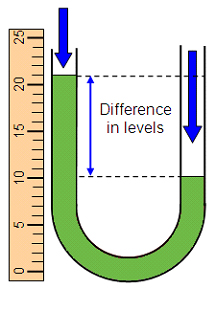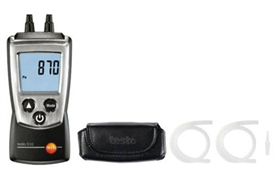What is a Digital Manometer?

What is Pressure
Before you can understand how a manometer works, you first need to know something about pressure. Pressure refers to the force applied to a surface of an object per unit area. You calculate it using the following formula;
| P=F/A Where P = Pressure, F= Force and A = Area. |
There are several units used to express pressure. Some derive from a unit of force divided by a unit of area; for example, the SI unit of pressure, the Pascal (Pa) is one Newton per square metre (N/m2). Common multiple units of the pascal are the Hectopascal (1 hPa = 100 Pa), which equals one millibar, and the kilopascal (1 kPa = 1000 Pa), which also equals one centibar. You'll find pascals used for applications like the measurement of atmospheric pressure.
Other units for measuring pressure include:
- Pound-force per square inch (psi): Psi is commonly associated with water pressure
- Millibars: Used in meteorology, where 1 bar = 100,000 pascal (Pa) and 1 millibar = 100 pascal (Pa)
- Torr: An alternative unit for expressing atmospheric pressure, defined as 1/760 of an atmosphere (133.3 Pa); and
- Millimetres of mercury (mmHg): The pressure exerted by a 1mm column of mercury - as found in blood pressure monitors, also known as Sphygmomanometers.
Measuring Pressure Using Manometers
So let's keep it a secret no longer - Manometers measure air pressure! The two main groups of Manometers are the traditional 'analogue' style and the more popular digital manometers.
Traditional Manometers
Analogue manometers use a simple and accurate mechanism to determine air pressure that involves fluid displacement. Water or mercury are alternative substances chosen to partially fill a "U" shaped tube left open at one or both ends (depending on the type). One end of the tube connects to a gas line for the introduction of pressure. When applied, the pressure displaces the liquid, simultaneously forcing it to rise on the other side of the 'U.' The result is measured on a scale, and the pressure level determined. (See figure 1 below).

Figure 1 Example of fluid displacement in a manometer
Digital Manometers
Rather than using fluids, digital manometers do the same job but use a pressure transducer. An elastic portion of the transducer detects pressure levels and converts this energy into an electronic signal, producing a number instantaneously on a digital display.
Uses for Digital Manometers
Applications occur in several industries. Common examples include:
- Monitoring and maintenance of HVAC systems
- Gas pressure monitoring; and
- Monitoring compressor systems.
Examples of Digital Manometers
Explore the vital information of the prime examples of digital manometers we've listed below.
Testo 510 Pocket Differential Pressure Manometer Set
Product Code: 0563-0510
The 0563-0510 accurately measures differential pressure in the range from 0 to 100 hPa. The differential pressure measurement displays in pascals after the instrument has applied temperature-compensation – which means greater accuracy.
Measuring Range: 0 to 100 hPa
Accuracy: ±0.03 hPa (0 to 0.30 hPa), ± 0.05 hPa (0.31 to 1.00 hPa), ± (0.1 hPa + 1.5 % of mv) (1.01 to 100 hPa)
Resolution: 0.01 hPa
Extech HD700 Differential Pressure Manometer (2psi).jpg)
Product Code: IC-HD700
The IC-HD700 is a simple-to-use, low range and high-resolution manometer with an impressive array of functions. The unit featuresMax/Min/Avg recording, relative timestamp,a built-in USB (software and cable included) and eleven selectable units of measure (inH2O, psi, mbar, kPa, inHg, mmHg, ozin2, ftH2O, cmH2O, kgcm2).
Measuring Range: Up to 2 psi
Accuracy: ±0.3%FS
Resolution: 0.001psi
Conclusion
Manometers are practical tools that measure air pressure. Many industries use them for a variety of applications.
Browse the complete range of manometers available at Instrument Choice here
*******************************************************************************
P.S. Want more information on digital manometers or need a hand finding the best for your application? Speak with an Instrument Choice Scientist! We're here to help! Call 1300 737 871 or email [email protected].
P.P.S. Learn why so many people trust Instrument Choice for their scientific instruments.
Also interesting
The multi-use IC-RC-5-Plus USB Temperature Data Logger is an ideal instrument for an assortment of applications, including auditing cold chains in the food and pharmaceutical industries and for monitoring fridges and freezers in laboratories.
For this article, the Instrument Choice Scientists have created a comprehensive guide on how to set up, start, and download collected data from the IC-RC-5-Plus.

Regular maintenance is crucial for the performance of the equipment you rely on, like your car, home, and health. In the same way, your weather station's routine maintenance will ensure accurate and reliable weather measurements for years to come.
This video article details how to maintain the IC0370 7-Inch Colour WiFi Wireless Weather Station.

